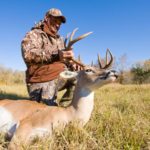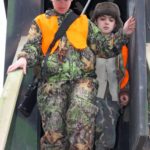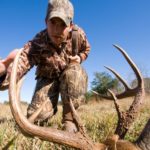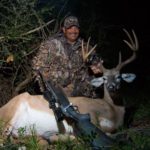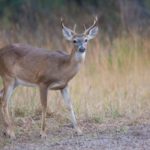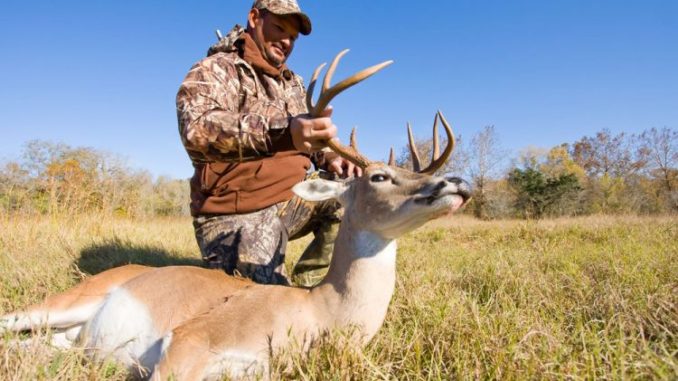
Needless to say, it’s pretty hard to harvest a deer if you never see anything from your stand. Local hunters weigh-in on conditions they like best for optimal action.
While sitting in my ground blind last season watching 15 deer second-lining down the lane I was hunting, I was struck by deer movement — and how it’s really the only factor that matters.
Think about it. I could have been hunting the biggest bucks over the best food plot out of the best box stand money could buy, but if the deer wouldn’t have been moving, I might as well have been back at the house watching The Bachelor with my wife.
No matter where I hunt, how I set up, or how scent-free I am, deer movement is critical to successfully bagging a deer — any deer — because the simple fact of the matter is if deer aren’t up and on their feet, I’m going home with my tag still in my pocket.
So what is it that puts deer up and at ‘em?
I guess if we had a definitive answer to that question we could just punch in to our stands 10 minutes before they got up and started moving — which would take just about every bit of the fun out of deer hunting.
Some say it’s the first hour of daylight, while others say it’s the last.
Some say to get in the stand before sunrise, while others say don’t even get out of bed until brunch.
Some say hunt the cloudy, rainy days, while others insist in only hunting sunny, bluebird days.
I think the answer is as varied as the hunting zones in Louisiana.
Of course the old adage that you can’t kill them if you’re sitting on the couch rings true, but how many of us can actually spend all day long in our stands in an effort to make sure we’re there when deer do start moving?
Unless you’re hunting from something that resembles a high-rise condo, an all-day hunt is a pretty tall order for anybody.
Ratchet down the pressure
In an odd twist, some hunters like Jeremy Tullos from Washington Parish believe the key is to keep deer on their feet — by never giving them a reason to get off of them in the first place.
“Low hunting pressure is key to keeping them comfortable enough to move,” he said. “If you’re trying to figure out when the deer are moving during the day while making them nocturnal because you’re hunting them so much, it’s kind of like you’re taking one step forward and two steps back.”
Tullos uses a low-impact approach that allows him to monitor when the deer are moving without even being in the woods.
“I’m using cameras that send the pics directly to your phone,” he said. “They keep me from going in and checking them, which also pressures deer, and I can tell exactly when they’re moving by a particular stand.”
But if you’re like me, knowing to stay out of an area to not pressure your deer — and actually doing it — are two entirely different things. It just takes so much willpower.
So aside from cellphone game cameras, how can you know when deer are up and moving during daylight without actually going into the woods?
Keep it cold
According to several deer hunters across the state, the number one thing to look for outside the rut is a good, hard cold snap.
“It’s so unusual to get really cold weather around here,” said Mike Phelps from Franklinton, “that when we get one it kind of forces them to get up and move.”
In his neck of the woods, Phelps has noticed that his local herd seems to like it cloudy with misting rain.
“It’s miserable conditions for the hunter, but I’ve shot a couple nice bucks in that kind of weather,” he said. “In my experience, the more miserable it is for me, the better my chances of seeing deer. So when my common sense is telling me to pack it in, that’s when I need to settle back into my stand and stay put.”
Phelps said a steady rain might even be better than a light drizzle, but he wouldn’t know because his common sense wins more often than not in those conditions and he just can’t take heavy rain and cold.
Curtis Simpson hunts around West Monroe, and agreed with Phelps.
“Hands down, a cold front is going to get them up and moving,” he said. “No doubt about it. Cold weather forces them to eat more because they burn more energy trying to stay warm. And when they’re eating more, they’re moving more. Only stands to reason that you’ve got better chances of seeing them on a cold day.”
Beyond just hunting a strong cold front, Simpson has noticed that the cold weather kind of makes deer in his area leave their bedding areas earlier in the afternoon ,and move back to them later in the morning.
“That means more daylight deer movement,” Simpson said. “So it doesn’t really matter if you’re hunting a food source or the trails going to their bedding areas: If the weatherman is predicting a cold day, make sure you’re in your stand.”
Like Tullos, Simpson tries not to over-hunt stands if the deer aren’t moving.
“No sense in blowing everything out just to sit there and see nothing,” he said. “If you kind of cherry pick your days and don’t hunt the days that aren’t good for deer movement, you’ll notice your stands lasting much longer into the season.”
Simpson added that he only hunts his best stands when everything is perfect. Otherwise, he stays out. The only exception he has is hunting a pipeline or high-line.
“Anywhere you can see a long way,” he said. “Then you can sit in your stand and still stay away from moving deer. You just have to take a longer shot.”
Opinions differ
As if to prove just how different local deer populations behave, Chuck Blackwell from Bogalusa said he has learned that the deer he hunts seem to prefer the falling barometric pressure leading up to a strong cold front coming through.
“You get a little window in there where the pressure is dropping as a front is passing through that lasts a little while after it passes,” Blackwell said. “After that it will start shooting back up with the high, bluebird days. I see a lot of deer movement in that little window of opportunity.”
Up around Vidalia and Ferriday, Eric Dumas spends a lot of time on a deer stand at Giles Island Hunting Club. He has hunted all over Louisiana though, and came to the realization a long time ago that every area is different when it comes to deer movement.
“Some areas they like overcast and raining,” said Dumas. “Other areas like here at Giles Island, they like sunshine and bluebird days. The only way to figure out when your deer like to move is to hunt a lot and take good notes. Once you see a trend starting to develop, you can start picking the days you hunt with a little more certainty.”
The old standby
When guiding hunters, Dumas doesn’t have the luxury of picking the days, so he falls back on the old standby morning and evening hunts.
“Let’s say you can only hunt on the weekends,” he said. “Well, you’re going to the woods whether it’s 80 degrees or 30 degrees because that’s the only day you’ve got. Sounds simple, but in that case, get in your stand before sunrise and hunt to about 10. After a midday break, head back and hunt 3:30 to dark. “Regardless of what the weather is doing, you can bet early-morning and late-evening is going to give you the best chance to see deer.”
So if you have the luxury of picking the days you get to hunt, there’s no doubt in these deer hunters’ minds that choosing the coldest days will definitely will up your odds of seeing deer. Now whether your deer prefer cold and cloudy — or cold and clear — is something you’ll have to figure out.
However, if work or school limits the days you can get in a stand, going early and late is key if you want to see deer moving. And while it’s true that hunting mid-morning to late afternoon is a great way to see big bucks, hunting mornings and evenings is a better way to see more deer in general.
Take notes
To better figure out deer movement for yourself, consider starting a hunting journal like Sid Havard from Simsboro did.
“I haven’t kept mine up for the last couple of years, but I have one that dates back maybe 40 years,” he said. “I started it way back in the days of hunting deer sign and trails long before people started putting out corn piles and planting food plots. It takes a little effort, but the rewards are well worth it.”
Havard suggested recording everything you can about every hunt – things like general weather conditions, wind direction, barometric pressure, moon phase, time of deer sightings, and direction of deer movement.
“It might take a while, but you’re going to eventually see patterns starting to emerge,” Havard said. “And it might seem crazy, but I’d say to keep a separate journal for your different hunting spots if they’re in different zones.
“Deer do different things in different areas, so recording what deer are doing in South Louisiana in a journal you keep for North Louisiana is just going to throw you off.”
I wish I would have been keeping a journal last year when all those deer marched down my lane, because the next time I hunted that stand I didn’t see a thing.
Something was different, but I don’t know what it was because I wasn’t paying attention to anything but the deer themselves.
Defining deer movement is never going to be an exact science, but with a little knowledge and a lot of record keeping, I’ll eventually nail down when my deer move best.
It’s up to you to do the same.
